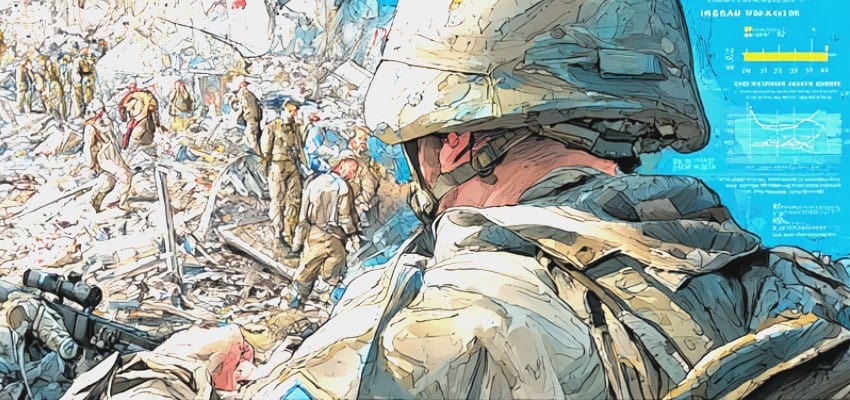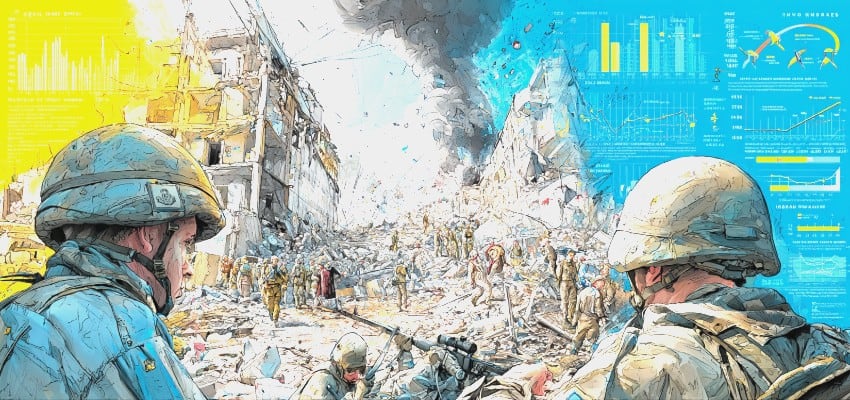Editor’s Note: This article presents a comprehensive analysis of the July 18, 2025 update from the Institute for the Study of War (ISW), detailing key developments across both military and geopolitical fronts in the ongoing Russo-Ukrainian War. Ukrainian forces continue to press counteroffensives in the south while Russian troops gain ground near Pokrovsk and Sumy. Simultaneously, the European Union has enacted a significant new sanctions package targeting Russia’s energy revenues, financial systems, and military supply chains, aiming to further strain the Kremlin’s capacity to wage sustained conflict. The analysis underscores the thesis that the convergence of battlefield attrition and escalating international economic pressure is steadily eroding Russia’s ability to maintain its war effort. This report is particularly relevant for those tracking the interplay between kinetic operations and strategic economic warfare in shaping the trajectory of the conflict.
For those seeking to grasp the full scope of this evolving landscape, the complete updates from the Institute for the Study of War serve as an invaluable resource.
Content Assessment: Economic Warfare Escalates: EU Strikes Russian Oil Revenues Amid Battlefield Tensions
Information - 93%
Insight - 94%
Relevance - 93%
Objectivity - 94%
Authority - 95%
94%
Excellent
A short percentage-based assessment of the qualitative benefit expressed as a percentage of positive reception of the recent article from ComplexDiscovery OÜ titled, "Economic Warfare Escalates: EU Strikes Russian Oil Revenues Amid Battlefield Tensions."
Background Note: ComplexDiscovery’s staff offers distinctive perspectives on the Russo-Ukrainian war and Middle Eastern conflicts, informed by their military experience on the West German, East German, and Czechoslovakian borders during the Cold War, as well as in Sinai as part of Camp David Accord compliance activities, during the timeframe of the Persian Gulf War. This firsthand regional knowledge has been further enhanced by recent staff travels to Eastern European countries, including Estonia, Finland, Latvia, Lithuania, and Poland. These visits have provided up-to-date, on-the-ground insights into the current geopolitical climate in regions directly impacted by the ongoing conflict.
Combined with cybersecurity, information governance, and eDiscovery proficiency, this multifaceted experience enables comprehensive analysis of these conflicts, including the critical impact of cyber warfare, disinformation, and digital forensics on modern military engagements. This unique background positions ComplexDiscovery to provide valuable insights for conflict-related investigations and litigation, where understanding the interplay of technology, data, and geopolitical factors is crucial.
Russo-Ukrainian Conflict Update*
Economic Warfare Escalates: EU Strikes Russian Oil Revenues Amid Battlefield Tensions
ComplexDiscovery Staff
The European Union’s recently enacted 18th sanctions package signals a critical turning point in the economic dimension of the Russo-Ukrainian War, aiming directly at the structural vulnerabilities of the Russian Federation’s wartime economy. Implemented on July 18, 2025, the measures particularly target Russia’s oil revenue streams—historically a linchpin of federal income—and further isolate the Kremlin from international financial mechanisms. Meanwhile, in the theaters of active combat, both Ukrainian and Russian forces are escalating operations, with Kyiv making limited but notable advances in the Novopavlivka direction and Moscow attempting a renewed push near Pokrovsk and Sumy.
Central to the EU’s new sanctions is a revised oil price cap, now pegged at $47.60 per barrel—15% below the average global price, which is anticipated to sharply undercut Russian export revenues. Complementary measures include an import ban on refined petroleum products derived from Russian crude sold through third countries (with exceptions) and a comprehensive ban on transactions related to the Nord Stream pipelines. Additionally, 105 more vessels from Russia’s so-called “shadow fleet” have been blacklisted, further eroding Moscow’s maritime logistics capabilities.
Economic countermeasures extend beyond energy. The sanctions sever financial messaging services for 22 Russian banks, reduce thresholds for penalizing third-country financial enablers, and prohibit software exports essential to Russia’s banking infrastructure. Moreover, the EU has taken aim at military-related entities, sanctioning PRC and Belarusian firms supplying dual-use technology to Russian forces, and has escalated restrictions on arms, ammunition, and precision machinery. Despite Kremlin assertions that these sanctions lack tangible effect, high-ranking Russian officials—including Energy Minister Tsivilev and Central Bank Chair Nabiullina—have signaled the mounting stress within the Russian economy, conceding difficulties in refinery maintenance and acknowledging a looming recession.
On the battlefield, the intensity of fighting remains acute across several axes. Ukrainian forces reported confirmed gains near Novopavlivka, specifically in the settlements of Yalta and Voskresenka, reinforcing a pattern of limited but persistent counterattacks designed to impede Russian momentum. In contrast, Russian forces advanced near Lysivka, southeast of Pokrovsk, in what appears to be a modest yet symbolically potent gain as part of a larger operation aimed at reclaiming control of Donetsk Oblast.
In northern Sumy Oblast, Russian forces launched multiple attacks toward Ukrainian positions near Kindrativka, Varachyne, and Yablunivka. Although these efforts failed to achieve breakthrough gains, Ukrainian defense spokesmen have highlighted a troubling trend: the deployment of Russian sabotage and reconnaissance units deep into Ukrainian rear areas, enabled by drone resupply operations. This evolving tactic—characterized by the use of “disposable” assault groups—suggests a shift in Russian strategy, one that leans on attritional disruption over territorial conquest.
The eastern front, encompassing Kharkiv, Luhansk, and northern Donetsk oblasts, saw heavy combat with no significant territorial changes. In Kharkiv Oblast, unconfirmed reports suggest limited Russian movement near Vovchansk. Further south, intense skirmishes in the Kupyansk, Borova, and Lyman directions illustrate Russia’s continued efforts to pressure Ukrainian defenses, albeit without conclusive success. Ukrainian sources noted a decline in Russian operational tempo around Siversk, attributing this to the destruction of better-trained Russian units—a development that could point to attritional fatigue among elite formations.
In the southern theater, Russian forces remain on the offensive in Hulyaipole and western Zaporizhzhia, with claims of intensified operations near Marfopil and Orikhiv. However, these efforts have yet to produce confirmed advances. Similarly, in the Kherson region, limited Russian attempts to cross the Dnipro River were reportedly unsuccessful. The southern axis thus remains a zone of grinding positional warfare, with no strategic breakthrough on either side.
Complementing the kinetic campaign, Russia’s air and drone operations continued at a steady pace. On the night of July 17–18, Russian forces launched 29 Shahed drones alongside six decoy drones from launch points in Rostov Oblast and Krasnodar Krai. Ukrainian air defenses intercepted 11 drones, while electronic warfare systems neutralized the decoys. Nonetheless, civilian infrastructure in Dnipropetrovsk Oblast sustained damage, resulting in one fatality—a grim reminder of Russia’s persistent campaign against Ukraine’s rear logistics and civilian morale.
Geopolitically, Kyiv moved to strengthen its war governance structure by appointing former Defense Minister Rustem Umerov as Secretary of the National Security and Defense Council. Umerov is tasked with overseeing arms coordination, joint defense production, and diplomatic engagement—roles that will likely be critical as Ukraine continues to navigate both battlefield dynamics and international partnership-building.
Meanwhile, the Kremlin escalated its domestic censorship efforts, with officials hinting at the imminent banning of WhatsApp, a platform with over 80 million daily Russian users. The state appears to be favoring the adoption of its own MAX messaging service while selectively tolerating Telegram due to its embedded Kremlin-linked channels. These moves are emblematic of Moscow’s broader effort to insulate the Russian digital space from Western influence and tighten information control in preparation for long-term mobilization.
On the industrial front, Belarus’s growing role in circumventing sanctions and supplying microelectronic components for Russian missile systems highlights the durability of Russia’s external support networks. Despite sanctions, Russian missile platforms like the Kh-101, Kh-69, and the Kinzhal ballistic missile reportedly continue to incorporate Belarusian microchips—underscoring the challenge Western powers face in achieving complete sanctions enforcement.
As both sides gear up for continued summer campaigns and the economic war deepens, the question remains: Can sanctions and attrition jointly degrade the Kremlin’s war machine fast enough to alter battlefield outcomes, or will Russia’s adaptations extend the conflict into another brutal winter?
Detailed Reporting with Maps for July 18, 2025, from the ISW – Mouseover to Scroll
Russo-Ukrainian War July 18 2025 - UpdateReview the Detailed Reporting and Maps PDF
About the Institute for the Study of War Research Methodology
ISW’s research methodology relies on both primary and secondary sources, enabling researchers to develop a comprehensive understanding of the situation on the ground. In order to analyze military and political developments in any given area, ISW’s research analysts must wholly understand the systems of enemy and friendly forces. They must also understand the population demographics, physical terrain, politics, and history of that area. This lays the analytical foundation for understanding the reasons for particular developments and fulfilling their assigned research objectives. ISW analysts also spend time in places like Iraq, Afghanistan, and elsewhere in order to gain a better understanding of the security and political situation and to evaluate the implementation of current strategies and policies. Their researchers compile data and analyze trends, producing a granular analysis of developments in areas of research, producing an accurate, high-resolution, timely, and thorough picture of the situation. ISW’s research methodology guarantees its success and commitment to improving the nation’s ability to execute military operations, achieve strategic objectives, and respond to emerging problems that may require the use of American military power.
About the Institute for the Study of War
The Institute for the Study of War advances an informed understanding of military affairs through reliable research, trusted analysis, and innovative education. They are committed to improving the nation’s ability to execute military operations and respond to emerging threats in order to achieve U.S. strategic objectives. ISW is a non-partisan, non-profit, public policy research organization.
Learn more, get involved, and contribute today.
Assisted by GAI and LLM Technologies
* Sourced and shared with direct expressed permission from the Institute for the Study of War (ISW).
Additional Reading
- From Dissent to OSINT? Understanding, Influencing, and Protecting Roles, Reputation, and Revenue
- Data Embassies: Sovereignty, Security, and Continuity for Nation-States
Source: ComplexDiscovery OÜ


























